 W
WAchilus flammeus, the red fungus bug, is a planthopper native to Australia, and accidentally introduced into Auckland City, New Zealand.
 W
WAcmaeops proteus is a species of the Lepturinae subfamily in the long-horned beetle family. This beetle is distributed in Canada, Mexico, and the United States.
 W
WAmmophila is the type genus of the subfamily Ammophilinae of the hunting wasp family Sphecidae. Ammophila is a large and cosmopolitan genus, with over 200 species, mostly occurring in the warmer regions of all continents apart from Antarctica.
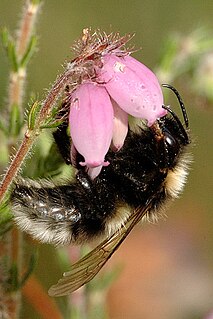 W
WBombus barbutellus, or Barbut's cuckoo-bee, is a species of cuckoo bumblebee, widespread, if not especially common, in most of Europe.
 W
WThe heath humble-bee or small heath bumblebee, Bombus jonellus, is a species of bumblebee, widely distributed in Europe and northern Asia, as well as northern North America.
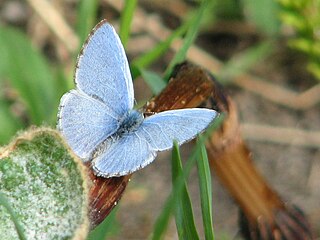 W
WCelastrina lucia, the lucia azure, northern azure, eastern spring azure or northern spring azure, is a species of butterfly of the family Lycaenidae. It is found eastern North America, ranging from the Maritimes south through the Appalachian Mountains to West Virginia.
 W
WThe Donaciinae, aquatic leaf beetles, are a subfamily of the leaf beetle family Chrysomelidae, characterised by distinctly long antennae. They are found in mainly the Holarctic, with very few species in the Southern Hemisphere.
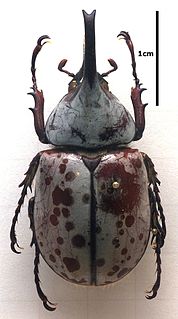 W
WDynastes is a genus of large beetles belonging to the family Scarabaeidae. They occur in the Nearctic realm and in the Neotropical realm, from the United States to Brazil; four North American species, three with distributions extending from Central America either north or south, and two species endemic to South America.
 W
WGnathocera is a genus of beetles belonging to the family Scarabaeidae.
 W
WLasioglossum malachurum, the sharp-collared furrow bee, is a small European halictid bee. This species is obligately eusocial, with queens and workers, though the differences between the castes are not nearly as extreme as in honey bees. Early taxonomists mistakenly assigned the worker females to a different species from the queens. They are small, shiny, mostly black bees with off-white hair bands at the bases of the abdominal segments. L. malachurum is one of the more extensively studied species in the genus Lasioglossum, also known as sweat bees. Researchers have discovered that the eusocial behavior in colonies of L. malachurum varies significantly dependent upon the region of Europe in which each colony is located.
 W
WLycaena dorcas is a species of butterfly in the family Lycaenidae, the gossamer-winged butterflies. Its common names include dorcas copper and cinquefoil copper. The species was first described by William Kirby in 1837. It is native to North America. The species L. dospassosi was once included in L. dorcas.
 W
WMegachile ligniseca is a species of bee in the family Megachilidae. It was described by William Kirby in 1802.
 W
WMegasoma is a genus of rhinoceros beetles. Commonly known as the elephant beetles, Megasoma species are found from the southern half of North America to most of South America.
 W
WMelitta is a genus of bees in the family Melittidae. It includes about 40 species restricted to Africa and the northern temperate zone. Most of the species are Palaearctic, though three rare species occur in North America.
 W
WThe milkweed leaf beetle is a species of beetle from the family Chrysomelidae.
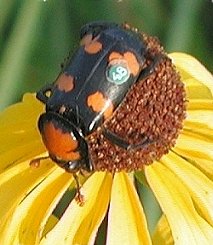 W
WNicrophorinae is a subfamily of burying beetles or carrion beetles. There are 65 living species of this subfamily, and 3 fossil species.
 W
WThe Nyctemerina are a subtribe of woolly bear moths in the family Erebidae.
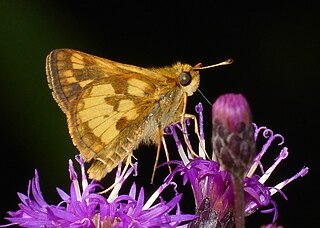 W
WPolites peckius, the Peck's skipper, is a North American butterfly in the family Hesperiidae (skippers), subfamily Hesperiinae. This skipper ranges across Canada from British Columbia, as far north as Cartwright, Labrador; Moar Lake, Ontario; Leaf Rapids, Manitoba; and the Hay River area in Alberta. In the US, it ranges in most of the northern and central states, except on the west coast.
 W
WThe Tok-tok beetles are ground-dwelling, Afrotropical beetles in the family Tenebrionidae. They are stout in shape and typically black or dark rufous in colour. They average about 2.6 cm in body length, but the Spindle toktokkie has an elongate body shape and measures 5.3 cm, while P. sulcicollis reaches 6 to 8 cm, and is the largest Tenebrionid in the world. Like the related genus Dichtha, the adults tap out a rhythm on the ground to attract and locate mates. Habitats are varied, from coastal forest to ridges, koppies, woodland and desert sand.
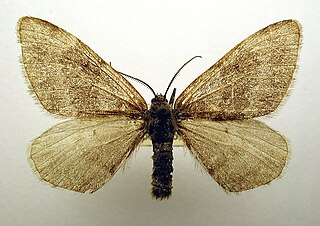 W
WPsychophora sabini is a moth of the family Geometridae first described by William Kirby in 1824. It is found in northern Europe, Asia and northern North America, including Greenland. The habitat consists of rocky heath, mostly above 1,000 meters above sea level.
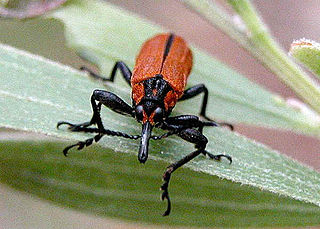 W
WRhinotia haemoptera, the red weevil, is a beetle species in the genus Rhinotia found in Australia. It resembles a fire-coloured beetle (Pyrochroidae) in colour. This insect pest can destroy groves and plantations of coconut and migrate to date palms and other palms, causing economic damage to farmers and landscapers.
 W
WSilphinae is a subfamily of burying beetles or carrion beetles. There are 113 extant species of this subfamily, in two tribe and in 14 genera.
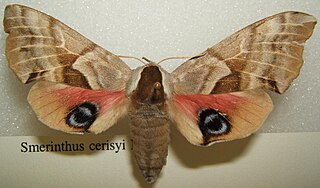 W
WSmerinthus cerisyi, the one-eyed sphinx or Cerisy's sphinx, is a moth of the family Sphingidae. The species was first described by William Kirby who named the species in honor of Alexandre Louis Lefèbvre de Cérisy in 1837. It is known from south-eastern Alaska, the southern parts of all Canadian provinces and in the northern border states of the United States south into northern Indiana, Pennsylvania and Ohio and along the west coast to southern California, eastward to the Rocky Mountains and into western New Mexico north to western North Dakota. It has also been recorded from Illinois and as far south as Missouri.
Stempfferia marginata, the scalloped epitola, is a butterfly in the family Lycaenidae. It is found in Nigeria, Cameroon, Gabon, the Republic of the Congo, the Central African Republic, the Democratic Republic of the Congo and Uganda. The habitat consists of forests.
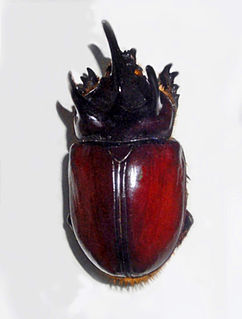 W
WStrategus is a genus of rhinoceros beetles belonging to the family Scarabaeidae. The genus is widespread in America from Kansas to South America.
 W
WThe Strepsiptera are an endopterygote order of insects with nine extant families that include about 600 described species. They are endoparasites in other insects, such as bees, wasps, leafhoppers, silverfish, and cockroaches. Females of most species never emerge from the host after entering its body, finally dying inside it. The early-stage larvae do emerge because they must find an unoccupied living host, and the short-lived males must emerge to seek a receptive female in her host. They are believed to be most closely related to beetles, from which they diverged 300–350 million years ago, but do not appear in the fossil record until the Mid-Cretaceous around 100 million years ago.
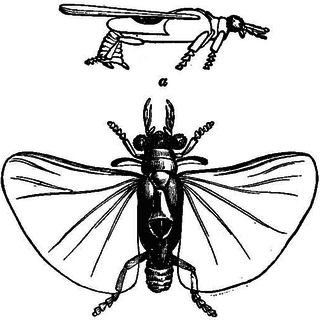 W
WStylopidae is a family of twisted-winged insects in the order Strepsiptera. There are about 15 genera and more than 330 described species in Stylopidae.
 W
WStylops is a genus of obligately endoparasitic insects in the family Stylopidae. Hosts are typically members of the order Hymenoptera. The official seal, and later logo, of the Royal Entomological Society features a male Stylops.
 W
WStylops melittae is a species of the order Strepsiptera of flying insects, that parasitize various species of sand bees (Andrena).
 W
WThe caddisflies, or order Trichoptera, are a group of insects with aquatic larvae and terrestrial adults. There are approximately 14,500 described species, most of which can be divided into the suborders Integripalpia and Annulipalpia on the basis of the adult mouthparts. Integripalpian larvae construct a portable casing to protect themselves as they move around looking for food, while Annulipalpian larvae make themselves a fixed retreat in which they remain, waiting for food to come to them. The affinities of the small third suborder Spicipalpia are unclear, and molecular analysis suggests it may not be monophyletic. Also called sedge-flies or rail-flies, the adults are small moth-like insects with two pairs of hairy membranous wings. They are closely related to the Lepidoptera which have scales on their wings; the two orders together form the superorder Amphiesmenoptera.